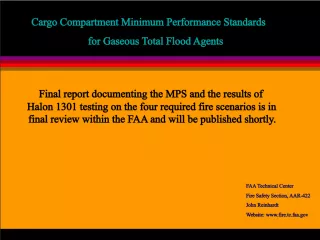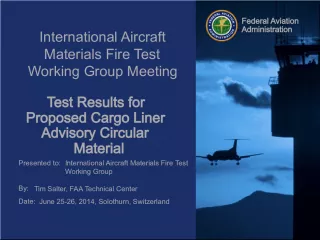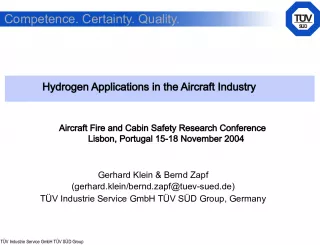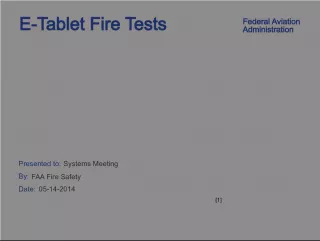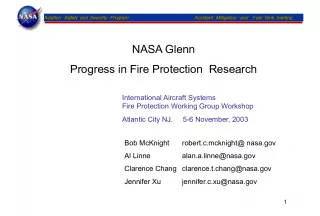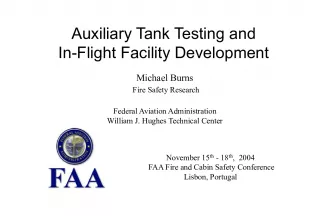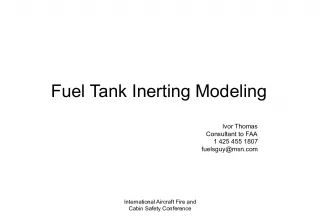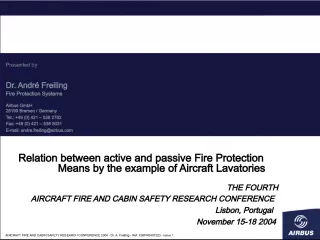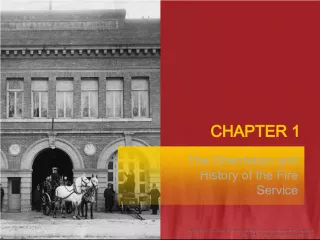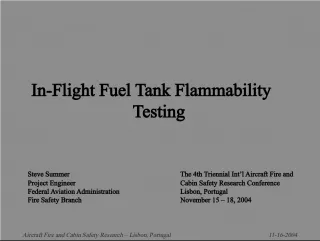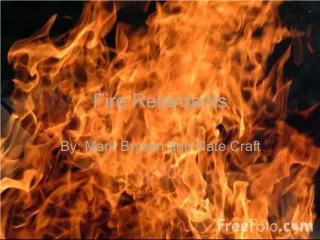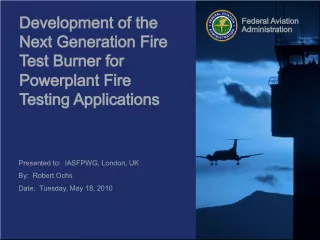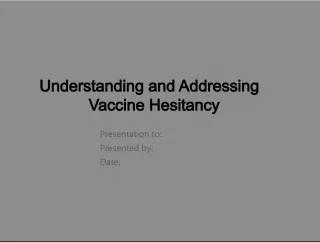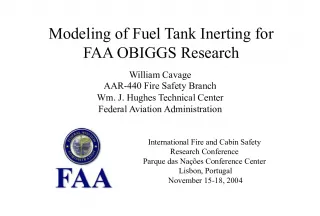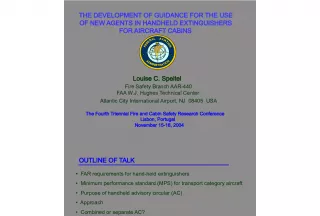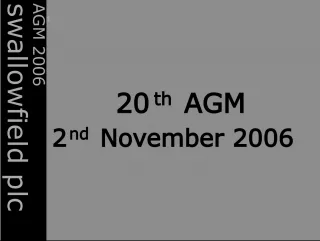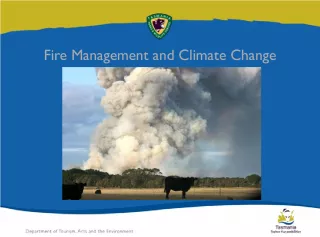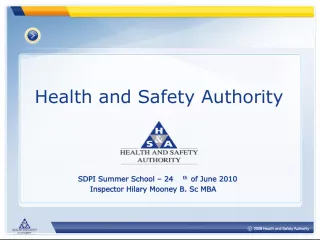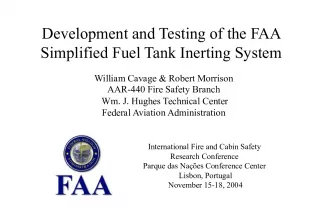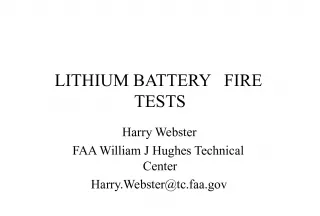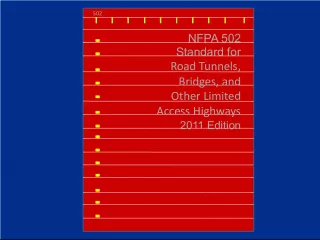Recommendations for Cargo Compartment Fire Safety
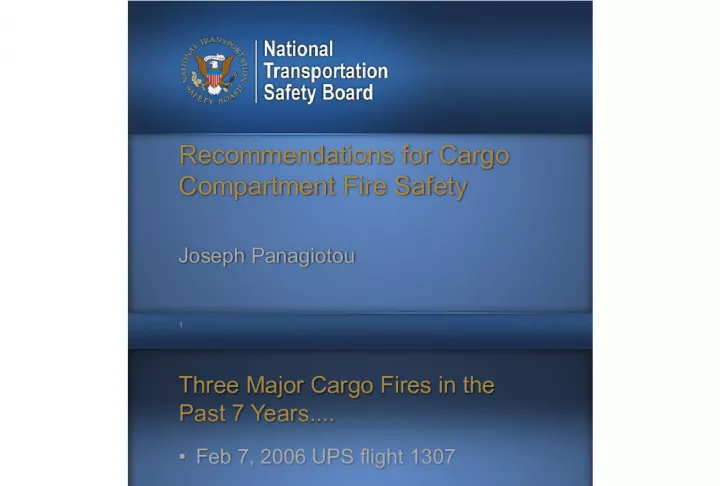

The article highlights the occurrence of three major cargo fires in the past seven years, namely UPS flight 1307 in Philadelphia, PA in February 2006, and UPS flight 006 in
- Uploaded on | 2 Views
-
 drishti
drishti
About Recommendations for Cargo Compartment Fire Safety
PowerPoint presentation about 'Recommendations for Cargo Compartment Fire Safety'. This presentation describes the topic on The article highlights the occurrence of three major cargo fires in the past seven years, namely UPS flight 1307 in Philadelphia, PA in February 2006, and UPS flight 006 in. The key topics included in this slideshow are . Download this presentation absolutely free.
Presentation Transcript
Slide1Recommendations for Cargo Compartment Fire Safety Recommendations for Cargo Compartment Fire Safety 1 Joseph Panagiotou Joseph Panagiotou
Slide2Three Major Cargo Fires in the Past 7 Years.... Three Major Cargo Fires in the Past 7 Years.... • Feb 7, 2006 UPS flight 1307 • Feb 7, 2006 UPS flight 1307 Philadelphia, PA. Philadelphia, PA. • Sept 3, 2010 UPS flight 006 • Sept 3, 2010 UPS flight 006 Dubai, UAE Dubai, UAE • July 28, 2011 Asiana Cargo flight 991 • July 28, 2011 Asiana Cargo flight 991 Jeju Island, South Korea Jeju Island, South Korea 2 2
Slide3UPS Flight 1307 UPS Flight 1307 • McDonnell Douglas DC-8 • McDonnell Douglas DC-8 • long time between smell of smoke and cargo fire alarm • long time between smell of smoke and cargo fire alarm • No fire suppression in flight • No fire suppression in flight • Unidentified fire source • Unidentified fire source • Aircraft was a total loss • Aircraft was a total loss NTSB Report: NTSB Report: http://www.ntsb.gov/doclib/reports/2007/A AR0707.pdf http://www.ntsb.gov/doclib/reports/2007/A AR0707.pdf 3 3
Slide4UPS Flight 006 UPS Flight 006 • Boeing 747-400F • Boeing 747-400F • 2 ½ minutes between cargo fire alarm and onset of system loss • 2 ½ minutes between cargo fire alarm and onset of system loss • Heavy smoke in the flight deck • Heavy smoke in the flight deck • suppression by depressurization ineffective • suppression by depressurization ineffective • aircraft out of control • aircraft out of control • Unidentified source • Unidentified source • loss of crew and aircraft • loss of crew and aircraft 4 4
Slide5Asiana Cargo Flight 991 Asiana Cargo Flight 991 • Boeing 747-400F • Boeing 747-400F • Short time between cargo fire alarm and control difficulties • Short time between cargo fire alarm and control difficulties • smoke in the flight deck • smoke in the flight deck • Aircraft out of control • Aircraft out of control • loss of crew and aircraft • loss of crew and aircraft This accident is still under investigation by the South Korean government. This accident is still under investigation by the South Korean government. 5 5
Slide6Accident Similarity Accident Similarity • short time between fire detection and onset of damage* • short time between fire detection and onset of damage* • smoke in flight deck* • smoke in flight deck* • no suppression • no suppression • unidentified source • unidentified source • loss of aircraft . • loss of aircraft . * The UPS flight 1307 fire did not exhibit these conditions. * The UPS flight 1307 fire did not exhibit these conditions. 6 6
Slide7Full Scale Container Fire Test Findings Full Scale Container Fire Test Findings • Container design effects time to detection • Container design effects time to detection • Exceeds 1 min detection time regulation • Exceeds 1 min detection time regulation • Container materials can add to the fire load • Container materials can add to the fire load • Fire growth rate after becoming detectable is rapid • Fire growth rate after becoming detectable is rapid For information about the NTSB’s cargo container fire study (NTSB Materials Laboratory Study Report 12-019), see case number DCA10RA092 on the NTSB’s website at http://www.ntsb.gov/investigations/dms.html. For information about the NTSB’s cargo container fire study (NTSB Materials Laboratory Study Report 12-019), see case number DCA10RA092 on the NTSB’s website at http://www.ntsb.gov/investigations/dms.html. http://www.fire.tc.faa.gov/pdf/systems/Nov11Meeting/Panagiotou-1111- HeatReleaseRate.pdf http://www.fire.tc.faa.gov/pdf/systems/Nov11Meeting/Panagiotou-1111- HeatReleaseRate.pdf 7 7
Slide8Current Regulations for Main Deck Cargo Compartments Current Regulations for Main Deck Cargo Compartments • Cargo container construction materials • Cargo container construction materials materials subjected to horizontal Bunsen burner test (UL-94) with a performance of < 4”/min materials subjected to horizontal Bunsen burner test (UL-94) with a performance of < 4”/min • Time to detection <1min • Time to detection <1min 14 CFR 25.858 14 CFR 25.858 • Suppression not required in Class E compartments • Suppression not required in Class E compartments 8 8
Slide9NTSB Recognizes That Progress is Being Made.. NTSB Recognizes That Progress is Being Made.. • UPS • UPS • FedEx • FedEx • FAATC • FAATC 9 9
Slide10NTSB recommendations for Cargo Compartment Safety NTSB recommendations for Cargo Compartment Safety Issued November 28, 2012 Issued November 28, 2012 Develop fire detection system performance requirements for the early detection of fires originating within cargo containers and pallets and, once developed, implement the new requirements. (A-12-68) (This safety recommendation supersedes Safety Recommendation A-07-98, which is classified “Closed—Acceptable Action/Superseded.”) Develop fire detection system performance requirements for the early detection of fires originating within cargo containers and pallets and, once developed, implement the new requirements. (A-12-68) (This safety recommendation supersedes Safety Recommendation A-07-98, which is classified “Closed—Acceptable Action/Superseded.”) http://www.ntsb.gov/doclib/recletters/2012/A-12-068-070.pdf http://www.ntsb.gov/doclib/recletters/2012/A-12-068-070.pdf 10 10
Slide11NTSB recommendations for Cargo Compartment Safety NTSB recommendations for Cargo Compartment Safety Ensure that cargo container construction materials meet the same flammability requirements as all other cargo compartment materials in accordance with Title 14 Code of Federal Regulations 25.855. (A-12-69) Ensure that cargo container construction materials meet the same flammability requirements as all other cargo compartment materials in accordance with Title 14 Code of Federal Regulations 25.855. (A-12-69) Require the installation and use of active fire suppression systems in all aircraft cargo compartments or containers, or both, such that fires are not allowed to develop. (A-12-70) Require the installation and use of active fire suppression systems in all aircraft cargo compartments or containers, or both, such that fires are not allowed to develop. (A-12-70) 11 11
